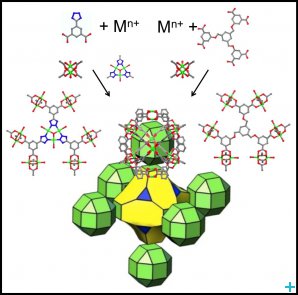The rht net: an ideal blueprint for the construction of a metal–organic framework platform
14.02.2013
The need for tunable functional solid-state materials is increasing because of the growing demand to address persisting challenges in global energy issues, environmental sustainability, and others. It is practical and preferable for such materials to be pre-designed and constructed to exhibit the desired properties and specific functionalities for a given targeted application.
NMI3 supported inelastic neutron scattering studies carried out on the FOCUS spectrometer at SINQ, Paul Scherrer Institute (PSI), which allowed identifying the rht net as an ideal blueprint for the construction of a metal-organic framework platform.
Metal–organic frameworks
Metal-organic frameworks (MOFs) have emerged as a unique class of solid-state materials. Given that it is possible to introduce a desired functionality pre- and/or post-synthesis, these materials have the required attributes and thereby offer great promise to unveil superior materials for many lasting challenges.
A remarkable feature of MOFs is the ability to build periodic structures with built-in functional properties using the molecular building block (MBB) approach. This approach utilizes pre-selected organic and inorganic MBBs with a desired function, which are carefully chosen to possess the proper geometry, shape, and directionality required to target given underlying nets for assembly.
Properties of an ideal blueprint
An ideal blueprint starts with a net that is singular, exclusive for the assembly of given building units, preferably encloses polyhedral cavities with 3D interconnecting channels; and is not susceptible to self-interpenetration upon net expansion and/or decoration. It is quite rare to find a material that combines all these properties.
The rht net
Edge-transitive nets (i.e. one kind of edge) are suitable targets in crystal chemistry and therefore are a prime source for obtaining singular nets for the rational construction of MOFs. The analysis of edge-transitive nets revealed an exceptional net – rht – which met all requisite criteria.
The rht net is singular for the assembly of 24-connected vertices (rhombicuboctahedral (rco) vertex figure) and 3-connected vertices (triangular vertex figure).
Researchers have found that the exceptional nature of the rht-MOF allows expansion without concern for interpenetration as well as building block substitution/decoration and functionalisation (i.e. isoreticular chemistry).
Gas storage or separation is one of the important potential applications of these materials, and these properties depend primarily on the way gas molecules bind to the framework of the host material.
Conclusion
The exceptional nature of the rht-MOF platform, based on a singular edge-transitive net (the only net for the combination of 3- and 24-connected nodes), makes it an ideal target in crystal chemistry. The high level of control indicates an unparalleled blueprint for isoreticular functional materials (without concern for interpenetration) for targeted applications.
NMI3 thanks Jan Peter Embs for reviewing this article. He is the responsible scientist for the cold-neutron time-of-flight spectrometer FOCUS at Paul Scherrer Institute (PSI), Villigen, Switzerland.
Published results:
Eubank, J.; Nouar, F.; Luebke, R.; Cairns, A.; Wojtas, L.; Alkordi, M.; Bousquet, T.; Hight, M.; Eckert, J.; Embs, J.; Georgiev, P.; Eddaoudi, M. (2012) On Demand: The Singular rht Net, an Ideal Blueprint for the Construction of a Metal–Organic Framework (MOF) Platform. Angew. Chem. Int. Ed., 51(40) 10099–10103
For a more complete description, please read Issue 4 of our newsletter.

